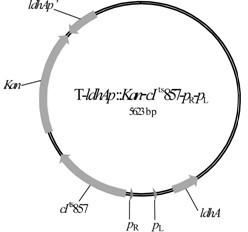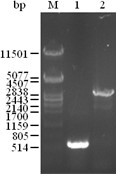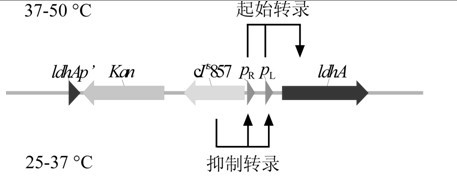Strain producing dynamic controlling recombinant strain and method for preparing D-lactic acid with recombinant strain
A technology of recombinant bacteria and lactic acid, applied in the fields of biochemical engineering, microbial fermentation engineering, and microbial genetic engineering, can solve the problems of affecting bacterial cells, increased lactic acid accumulation, lack of three-carbon intermediate metabolites, etc., and achieve the effect of ensuring polymer-grade quality.
- Summary
- Abstract
- Description
- Claims
- Application Information
AI Technical Summary
Problems solved by technology
Method used
Image
Examples
Embodiment 1
[0049] Example 1 : Replacement of the Chromosomal Lactate Dehydrogenase Promoter in Escherichia coli by a Temperature-Regulated Promoter
[0050] Using primers Ec-lA3-5 and YldhA3 PCR amplification of B0013-070 chromosome wxya Gene fragment wxya ’, cloned into the pMD18-T simple vector to obtain the recombinant plasmid T- wxya '. Plasmid pPL451 (Gene, 1996, 176: 49~53) was amplified by reverse PCR with primers PPL1 and PPL2, and combined with the kanamycin resistance gene fragment (plasmid pSK sym Km (Applied Microbiology and Biotechnology, 1999, 52: 820~828) use restriction enzymes, such as Sma I was digested, and the gel recovered a 966 bp fragment) for ligation to obtain the recombinant plasmid pPL- Kan . Plasmid pPL- Kan Carry out PCR amplification, and the products are treated with restriction endonucleases, such as Eco RI and Stu I carry out double digestion, and with T- wxya ' is used as the template to carry out inverse PCR amplification with primers Ec-...
Embodiment 2
[0051] Example 2 : Strain B0013-070B p R -p L Determination of promoter activity
[0052] The strains B0013-070 and B0013-070B were respectively at 25~36 ° C and 37~50 ° C was cultured for 2~10 h, and its medium was (g / L): yeast extract 15, peptone 0.5, anhydrous MgSO 4 0.25, glucose 5. And determine their lactate dehydrogenase (LDH) specific enzyme activity, the typical results are as follows Figure 4 shown. Strain B0013-070B in 30 ° C produced only very low amounts of LDH activity. at 42 ° C culture, the LDH activity of the strain B0013-070B is 2.2 times that of the starting strain B0013-070, which is sufficient for lactic acid synthesis. Strain B0013-070 in 30 ° The specific enzyme activity value of LDH cultivated in C was calibrated as 100%, compared with this, the strain was at 42 ° LDH enzyme activity decreased when C grew. Explain that the temperature change is used to control the strain B0013-070B p R - p L The promoter effectively controls the wx...
Embodiment 3
[0053] Example 3 : Production of lactic acid by fermenting glucose in a 7 L fermenter
[0054] Strain B0013-070B was subjected to lactic acid fermentation in a 7 L fermenter to test the effect of temperature-regulated LDH expression under controlled production conditions. Strain B0013-070B at 25~36 ° C for aerobic culture to OD 600 The value is about 15~40, set the fermenter temperature to 37~50 ° C continued aerobic culture for 0~120 min, and then set the ventilation rate to 0~0.2vvm for oxygen-limited fermentation, and the fermentation temperature in the oxygen-limited stage was 37~50 ° c. Its fermentation medium is (g / L): yeast extract 0~25, peptone 0~2.5, MgSO 4 0~0. 5, CaCO 3 0~175, pH 6.0~7.5. The concentration of lactic acid, by-products and bacteria in the fermentation process such as Figure 5 shown.
[0055] The conversion rate of aerobic cells of the strain B0013-070B was 9% higher than that of the fermentation tank of the strain B0013-070, indicating tha...
PUM
| Property | Measurement | Unit |
|---|---|---|
| optical purity | aaaaa | aaaaa |
| purity | aaaaa | aaaaa |
Abstract
Description
Claims
Application Information
 Login to View More
Login to View More - R&D
- Intellectual Property
- Life Sciences
- Materials
- Tech Scout
- Unparalleled Data Quality
- Higher Quality Content
- 60% Fewer Hallucinations
Browse by: Latest US Patents, China's latest patents, Technical Efficacy Thesaurus, Application Domain, Technology Topic, Popular Technical Reports.
© 2025 PatSnap. All rights reserved.Legal|Privacy policy|Modern Slavery Act Transparency Statement|Sitemap|About US| Contact US: help@patsnap.com



